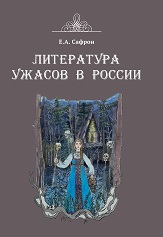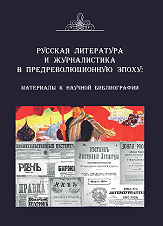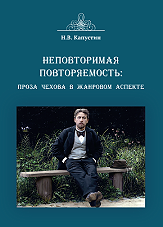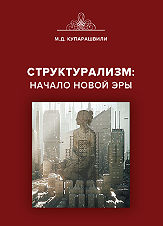Igosheva Tatiana V.,
Doctor of Philology, Leading Researcher
Institute of Russian Literature (Pushkin House) of the
Russian Academy of Sciences
e-mail: tigosheva@mail.ru
https://orcid.org/0000-0001-7988-204X
The article is devoted to the study of the practically unexplored influence of the English science fiction writer H.J. Wells on the formation of a number of images in the modernist novel by Mikhail Zenkevich “The Peasant Sphinx” (1921–1928). Zenkevich was familiar with Wells’s works not only as a reader, but also as a translator and editor of translations of his works. Interest in Wells’s science fiction novels arose in the second half of the 1920s, when Zienkiewicz continued to work on his own novel. As a result of the comparative analysis, figurative and motivic overlaps between the two authors were identified. These include motifs of time travel and crossing the border between two worlds, images of the sphinx and “heat rays,” and the idea of the fourth dimension. In addition to the intertextual “dialogue” that Zenkevich conducts in his novel, the original artistic method developed by Wells (which differs significantly, for example, from the method of J. Verne) also turned out to be important for him. The article analyzes an episode from “The Peasant Sphinx,” which is not a science fiction novel, but where a recognizably Wellsian method of organizing the scientific impression of an artistic image, which in fact was not scientifically substantiated, was nevertheless applied. Based on real scientific facts, Zenkevich in the episode being analyzed gives freedom to his artistic imagination, the final task of which is not a plausible scientific description of the emitting apparatus, but the creation of a spectacular, impressive image. The study led to the conclusion that Wells’s influence on the poetics of Zenkevich’s novel “The Peasant Sphinx” occurred along two vectors simultaneously: the path of intertextual borrowing and the path of organizing the fantastic on the basis of scientific fact according to Wells’ method.
Keywords Mikhail Zenkevich, the novel “The Peasant Sphinx”, H.J. Wells, influence, poetics, intertext, artistic method
References
1. Uells G.Dzh. Polnoe sobranie fantasticheskikh romanov: v 15 t. / pod red. M. Zenkevicha. Moscow; Leningrad: Zemlia i Fabrika, 1930–1931. 208 s.
2. Uells G. Bor’ba mirov / per. M. Zenkevicha // Uells G. Fantastika. Moscow: Khudozh. lit., 1935. S. 267–435.
3. Igosheva T.V. Roman M. Zenkevicha «Muzhitskii sfinks»: mezhdu arkhaikoi i modernom // Russkii modernizm: Poetika. Tekstologiia. Istoriko-literaturnyi kontekst: kol. monogr. otv. red. N.Iu. Griakalova. St. Petersburg: ART-BUK, 2022. S. 199–220.
4. Gumilev N.S. Pis’ma o russkoi poezii. Moscow: Sovremennik, 1990. 383 s.
5. Nakhin P.Dzh. Tainy mashiny vremeni. Puteshestviia vo vremeni v fizike, filosofii i fantastike. Moscow: DMK Press, 2021. 375 s.
6. Zenkevich M.A. Skazochnaia era: Stikhotvoreniia. Povest’. Belletristicheskie memuary / sost., podgot. tekstov, primech., kratkaia biokhronika S.E. Zenkevicha; vstupit. st. L.A. Ozerova. Moscow: Shkola-Press, 1994. 688 s.
7. Uail’d O. Polnoe sobranie sochinenii v odnom tome. Moscow: Eksmo, 2014. 880 s.
8. Wells H.J. The time machine. London: William Heinemann, 1895. 152 pp.
9. Igosheva T.V. Roman M.A. Zenkevicha «Muzhitskii sfinks»: o se-mantike zaglaviia // Russkii modernizm i ego nasledie: kol. monogr. v chest’ 70-letiia N.A. Bogomolova. Moscow: NLO, 2021. S. 381–402.
10. Luknitskii P.N. Acumiana. Vstrechi s Annoi Akhmatovoi. 1924–1925. Parizh: YMCA-Press, 1991. T. 1. 349 s.
11. Kagarlitskii Iu.I. Vgliadyvaias’ v budushchee. Kniga o Gerberte Uellse. Moscow: Kniga, 1989. 351 s.
12. Г Luchi smerti // Radioliubitel’. 1924. No. 1. S. 2.
13. Chernaia N.I. V mire mechty i predvideniia. Nauchnaia fantastika, ee problemy i khudozhestvennye vozmozhnosti. Kiev, 1972. 228 s.
14. Voronskii A.K. Iskusstvo videt’ mir / sost. A.G. Voronskaia, I.S. Isaev. Moscow: Sovetskii pisatel’, 1987. 702 s.
15. Zamiatin E. G.Dzh. Uells // Uells G.Dzh. Mashina vremeni. Petrograd, 1920. S. 3–12.





.png)







